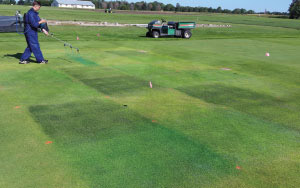TURF COLOURANTS MAY AFFECT SHADE TOLERANCE
Says research out of America
An article by Bill Kreuser, Ph.D in the American magazine Golfdom, says that the use of turf colourants may be affecting shade tolerance.
He says, "Applying plant colourants to turfgrass has become increasingly popular in the golf industry. This has led to an explosion of new colourant products that are marketed to alleviate UV stress, extend the growing season, cool the plant and induce plant systemic resistance against pests.

Plant colourants are applied to a creeping bentgrass fairway plot in Mead, Neb. The plot is then covered with shade cloth to reduce sunlight intensity by 70 percent. Photo: Bill Kreuser
"Most colourants are an emulsion that contain the green mineral pigment phthalocyanine. Prior research showed that turf colorants sustained turfgrass health during exposure to UV light in a growth chamber. The pigments likely quenched the damaging UV light before it reached plant tissue.
"Other research showed plant colourants also absorb a significant amount of red and far-red light. This light is important for photosynthesis and may affect shade tolerance. The objective of this study is to determine how colourants affect creeping bentgrass grown in shade.
"This study is being conducted on a creeping bentgrass ‘L-93’ fairway at the John Seaton Anderson Turf Center in Mead, Neb. Different colorant products are applied at various rates every 10 days. The plot is covered with shade cloth to reduce sunlight intensity by 70 percent.
"Turfgrass visual quality rating, tiller density rating, chlorophyll content, turf canopy temperature and clipping yield are measured weekly during the summer. Photosynthesis and tiller density measurements will be taken at the end of each growing season.
"The 70 percent shade has had a dramatic effect on turfgrass quality and tiller density rating. Colourants initially improved turfgrass quality because they increased the green appearance. However, colourants appear to have accelerated decline in turfgrass tiller density by July. The colourants also dyed the top of the sand root zone blue and increased the canopy temperature a couple degrees Fahrenheit.
"We’ll continue to monitor the response for another year. Until then, use caution with plant colourants under heavy shade."
|